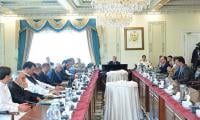After reading my previous column ‘Getting education right’, published in these pages on January 13, many readers wondered if peace and harmony could be achieved through education in Pakistan. As a student of comparative education, one comes across several case studies where education has progressed fast and within a span of couple of decades some countries displayed outstanding results. Japan is one such case in point. The Meiji Restoration (also called the Meiji Revolution) that started in 1868 had transformed the Japanese society by the end of the century. Can that be done in Pakistan?
First we need to understand that the enlightened leadership of the Meiji state perceived there was a connection between modern education for the masses and modern methods of governance. In the early 1870s, they introduced the modern school system. These enlightened leaders were from both the political sphere as well as from the civil and military bureaucracy. They won the political battle inside the central government despite a strong resistance from the agrarian lobby. These leaders managed to mobilise the masses into the new system of education and politics by the turn of the century.
During the first decades of the 20th century, the mobilisation of the whole nation was almost complete. It permeated into the masses a mindset based on modern western science as promoted by enlightened leaders and intellectuals. In other countries where rapid progress in education was made – such as in Russia and China – a similar trend can be noticed; a new political leadership supported by a strong intellectual lobby that was ready to discuss, read, and write and involve large sections of society.
Meiji in Japan is a rare case that explains what happened when a feudal state suddenly encountered full-scale education. It resulted in a modern industrialised state almost at par with England, France, and the US. It is noteworthy that the Meiji state’s rapid abolishment of feudal domains made it possible for the government to discard various systems that hampered economic advancement. Enforcement of universal mass education became possible in this situation. The new nobility attended the institutions of higher education during the early Meiji period almost exclusively. The University of Tokyo was built in 1877 and commoners were permitted to enter the Tokyo University Preparatory School one year later.
The Economist in its January 13 to 19 issue carried three articles about Japan, including one about the 150th anniversary of the Meiji Restoration. It highlights how a band of young revolutionaries, mostly coming from the Samurai class, overthrew the Tokugawa Shogunate and with it the seven centuries of feudal rule, the stratified society of which was absurdly rigid, – not very different from what we have had in Pakistan. During the Meiji restoration a 12-year old emperor Mutsuhito was put on the throne. Mutsuhito died in 1912 and was posthumously given the title of Emperor Meiji, hence the name: the Meiji Restoration.
In April 1868, a famous ‘Charter [of] Oath’ had announced that, “Knowledge shall be sought throughout the world.” The government sent 50 high officials on a two-year world tour to learn about education, industry, trade and warfare from the American and European governments. Back in Japan they introduced a flurry of administrative reforms and industrial developments. These changes were so grand and rapid that the Meiji restoration almost felt like a revolution. This gave birth to a new group of bureaucrats, intellectuals and political leaders who wanted to have universal mass education despite unfavourable political and social conditions.
An important factor in this transformation was the exposure the political leadership attained during the Meiji restoration with the European civilisation enabling it to quickly experience the great advantages of its importation. The political success of the movement was owed significantly to the dissatisfaction of the masses towards the incompetent feudal system. The new government was viewed as a liberator from the old social system. The new government gradually removed feudal economic and social regulations. For education, the government introduced an unfamiliar system based on Gakusei (The fundamental code of education).
Gakusei was Japan’s first national scheme of mass education issued in 1872; one year after Monbusho (ministry of education) was established in 1871. Initially, it had around 100 chapters but a year later, in 1873, another 100 chapters were added with the goal to establish a university in each district and around 55,000 elementary schools throughout the country. The design called for 600 Japanese to be assigned to one elementary school. The Gakusei covered all levels of education, from elementary and secondary to tertiary and professional colleges such as medical, law, business and industrial schools.
Gakusei also covered curriculum, examinations, diplomas, qualifications and also defined the roles of teachers and school administrators, regulated studying abroad, school fees and education loans. In Pakistan, however, we still have to form a policy that can match the breadth and depth of the Gakusei. We have had several education policies which were full of platitudes and assertions about the importance of inculcating Islamic, cultural and nationalistic values. Increasing obsession with religiosity has hampered critical thinking and we have not learned anything from countries that have transformed their education systems.
So, as to summarise, here is the gist. In Japan there first emerged a strong group of enlightened leaders who led the nation. In Pakistan that is still missing. In Japan, that group came from diverse backgrounds such as the civil and military bureaucracy, political leaders and business elites, who had their differences but managed to work in tandem to reform the country.
In Pakistan, enlightened leaders and intellectuals are humiliated, mocked, killed, tortured, forcibly disappeared or compelled to live a life of exile or seclusion. These stalwarts include Mian Iftikharuddin, Sajjad Zaheer, Faiz, HS Suhrawardy, Abdul Ghaffar Khan, GM Syed and Hasan Nasir to ZA Bhutto, Meraj M Khan, RB Palijo, Fazil Rahu, Nazeer Abbasi, MGB Bizenjo, Wali Khan, Benazir Bhutto, Aslam Azhar, Rashid Rahman, Sabeen Mahmood, to the tortured bloggers and Professor Zafar Arif, the list is endless and still growing.
In Japan not everything was right. With education there was militarism that they had to forego after the Second World War. In the past 70 years, Japan capitalised on its universal education and scientific mindset. But in Pakistan this still seems to be a far cry, unless our state organs and political leaders decide to allow an enlightenment to take root. If the recent events are any guide –such as the sit-in in Islamabad, the alleged murders of political dissenters and the opposition’s rally in Lahore, then rest assured that a Japan-like transformation is at least a century away.
The writer holds a PhD from the University of Birmingham, UK and works in
Islamabad. Email: Mnazir1964@yahoo.co.uk
People stand in line up as election officials check their ballot papers during voting general election at a polling...
Women show their voter identity cards as they stand in a queue before casting their votes in Agartala. — PTIThe 18th...
Former prime minister Imran Khan. — Instagram/ imrankhan.ptiAn old saying has it that “when you dance with the...
Kashmiris in Indian illegally occupied Kashmir protesting against the Indian occupation as the forces of India looked...
A representational image showing residents walking at a wholesale market in Karachi. — AFP/FileOnce again there is...
A representational image showing late Pakistani human rights activist and Supreme Court lawyer Asma Jahangir. —...







